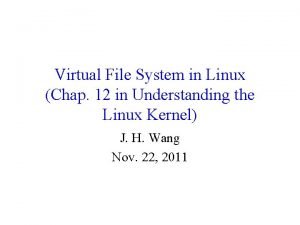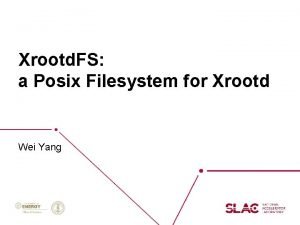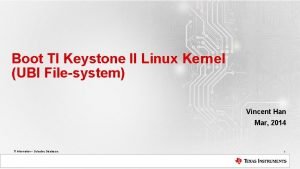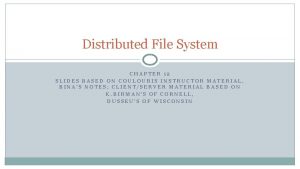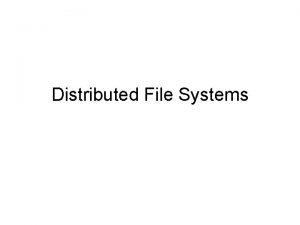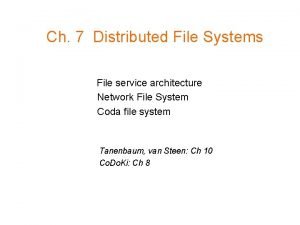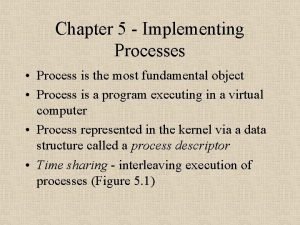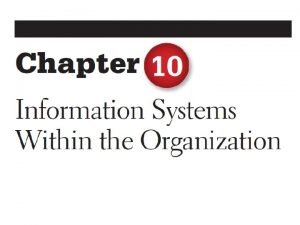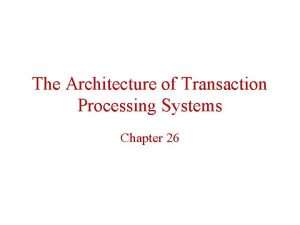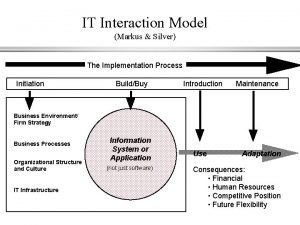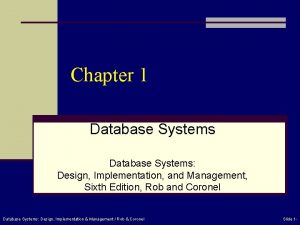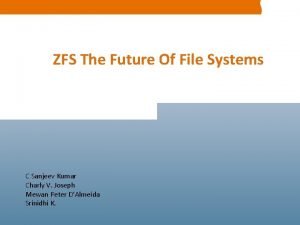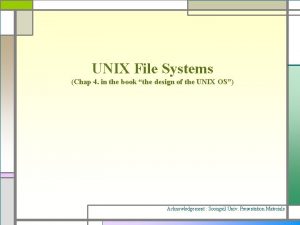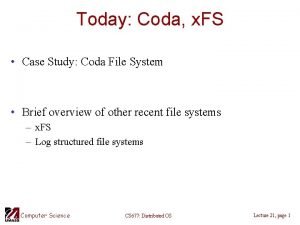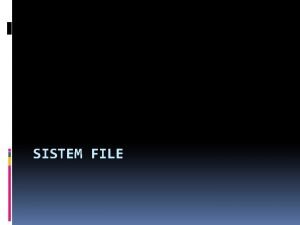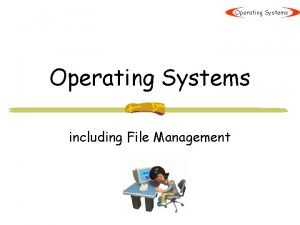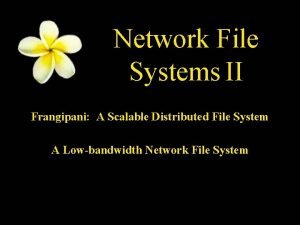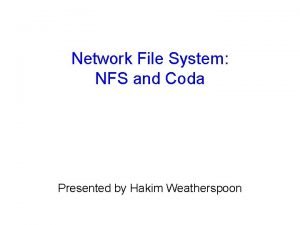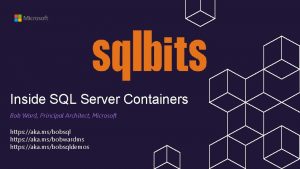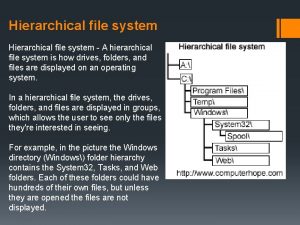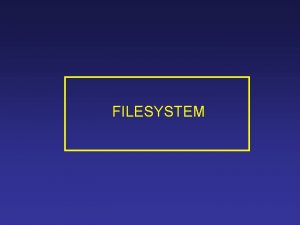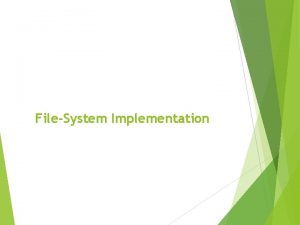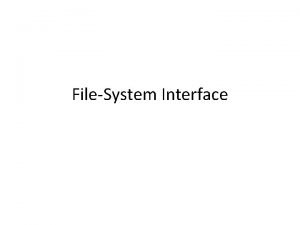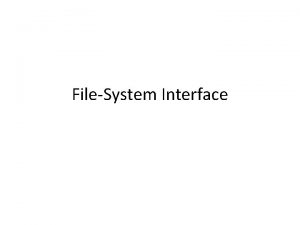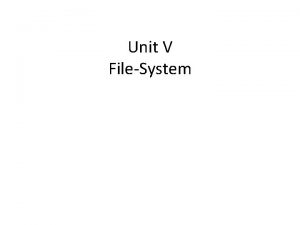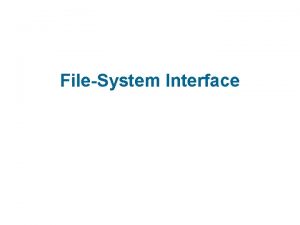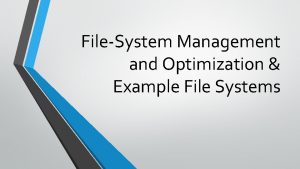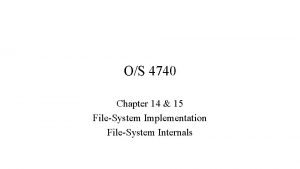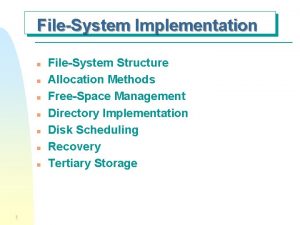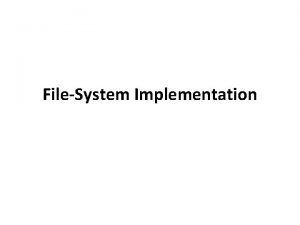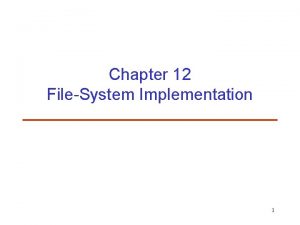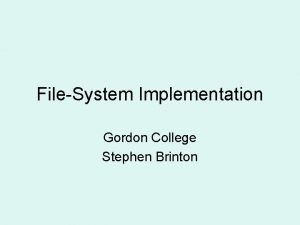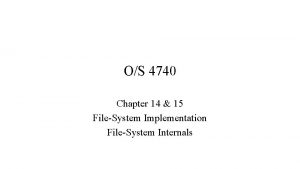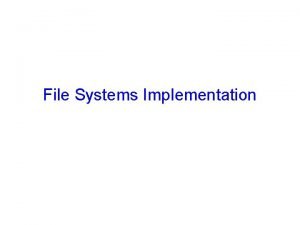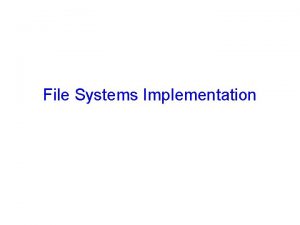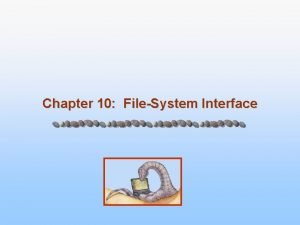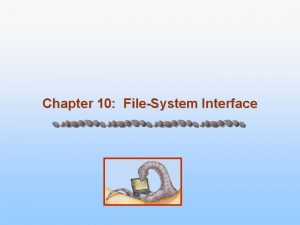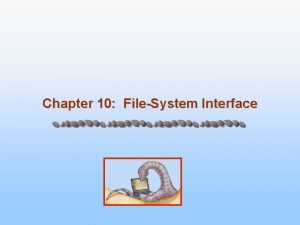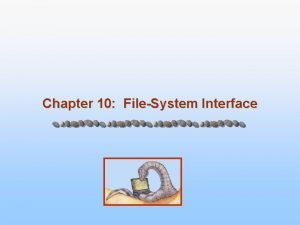File System Implementation File System Implementation n FileSystem





















![Free-Space Management n Bit vector (n blocks) 0 1 2 n-1 … bit[i] = Free-Space Management n Bit vector (n blocks) 0 1 2 n-1 … bit[i] =](https://slidetodoc.com/presentation_image/7786ecac3c90c7dfa759e1f54a1925f2/image-22.jpg)


















- Slides: 40

File System Implementation

File System Implementation n File-System Structure n File-System Implementation n Directory Implementation n Allocation Methods n Free-Space Management n Efficiency and Performance n Recovery n Log-Structured File Systems n NFS n Example: WAFL File System

Objectives n To describe the details of implementing local file systems and directory structures n To describe the implementation of remote file systems n To discuss block allocation and free-block algorithms and trade-offs

File-System Structure n File structure l Logical storage unit l Collection of related information n File system resides on secondary storage (disks) n File system organized into layers n File control block – storage structure consisting of information about a file

Layered File System

A Typical File Control Block

In-Memory File System Structures Opening a file Reading a file

Virtual File Systems n Virtual File Systems (VFS) provide an object-oriented way of implementing file systems. n VFS allows the same system call interface (the API) to be used for different types of file systems. n The API is to the VFS interface, rather than any specific type of file system.

Schematic View of Virtual File System

Directory Implementation n Linear list of file names with pointer to the data blocks. l simple to program l time-consuming to execute n Hash Table – linear list with hash data structure. l decreases directory search time l collisions – situations where two file names hash to the same location l fixed size

Allocation Methods n An allocation method refers to how disk blocks are allocated for files: n Contiguous allocation n Linked allocation n Indexed allocation

Contiguous Allocation n Each file occupies a set of contiguous blocks on the disk n Simple – only starting location (block #) and length (number of blocks) are required n Random access n Wasteful of space (dynamic storage-allocation problem) n Files cannot grow

Contiguous Allocation of Disk Space

Extent-Based Systems n Many newer file systems (e. g. , Veritas File System) use a modified contiguous allocation scheme n Extent-based file systems allocate disk blocks in extents n An extent is a contiguous block of disks l Extents are allocated for file allocation l A file consists of one or more extents.

Linked Allocation n Each file is a linked list of disk blocks: blocks may be scattered anywhere on the disk. block = pointer

Linked Allocation

File-Allocation Table

Indexed Allocation n Brings all pointers together into the index block. n Logical view. index table

Example of Indexed Allocation

Indexed Allocation – Mapping (Cont. ) outer-index table file

Combined Scheme: UNIX (4 K bytes per block)
![FreeSpace Management n Bit vector n blocks 0 1 2 n1 biti Free-Space Management n Bit vector (n blocks) 0 1 2 n-1 … bit[i] =](https://slidetodoc.com/presentation_image/7786ecac3c90c7dfa759e1f54a1925f2/image-22.jpg)
Free-Space Management n Bit vector (n blocks) 0 1 2 n-1 … bit[i] = 0 block[i] free 1 block[i] occupied Block number calculation (number of bits per word) * (number of 0 -value words) + offset of first 1 bit

Free-Space Management (Cont. ) n Bit map requires extra space l Example: block size = 212 bytes disk size = 230 bytes (1 gigabyte) n = 230/212 = 218 bits (or 32 K bytes) l Easy to get contiguous files n Linked list (free list) l Cannot get contiguous space easily l No waste of space n Grouping n Counting

Free-Space Management (Cont. ) n Need to protect: Pointer to free list l Bit map 4 Must be kept on disk 4 Copy in memory and disk may differ 4 Cannot allow for block[i] to have a situation where bit[i] = 1 in memory and bit[i] = 0 on disk l Solution: 4 Set bit[i] = 1 in disk 4 Allocate block[i] l 4 Set bit[i] = 1 in memory

Linked Free Space List on Disk

The Sun Network File System (NFS) n An implementation and a specification of a software system for accessing remote files across LANs (or WANs) n The implementation is part of the Solaris and Sun. OS operating systems running on Sun workstations using an unreliable datagram protocol (UDP/IP protocol and Ethernet

NFS (Cont. ) n Interconnected workstations viewed as a set of independent machines with independent file systems, which allows sharing among these file systems in a transparent manner l A remote directory is mounted over a local file system directory 4 The mounted directory looks like an integral subtree of the local file system, replacing the subtree descending from the local directory

NFS (Cont. ) l Specification of the remote directory for the mount operation is nontransparent; the host name of the remote directory has to be provided 4 Files in the remote directory can then be accessed in a transparent manner l Subject to access-rights accreditation, potentially any file system (or directory within a file system), can be mounted remotely on top of any local directory

NFS (Cont. ) n NFS is designed to operate in a heterogeneous environment of different machines, operating systems, and network architectures; the NFS specifications independent of these media n This independence is achieved through the use of RPC primitives built on top of an External Data Representation (XDR) protocol used between two implementation-independent interfaces n The NFS specification distinguishes between the services provided by a mount mechanism and the actual remote-file-access services

Three Independent File Systems

Mounting in NFS Mounts Cascading mounts

NFS Mount Protocol n Establishes initial logical connection between server and client n Mount operation includes name of remote directory to be mounted and name of server machine storing it l Mount request is mapped to corresponding RPC and forwarded to mount server running on server machine l Export list – specifies local file systems that server exports for mounting, along with names of machines that are permitted to mount them n changes only the user’s view and does not affect the server side

NFS Mount Protocol n Following a mount request that conforms to its export list, the server returns a file handle—a key for further accesses n File handle – a file-system identifier, and an inode number to identify the mounted directory within the exported file system n The mount operation changes only the user’s view and does not affect the server side

NFS Protocol n Provides a set of remote procedure calls for remote file operations. The procedures support the following operations: l l l searching for a file within a directory reading a set of directory entries manipulating links and directories accessing file attributes reading and writing files

NFS Protocol n NFS servers are stateless; each request has to provide a full set of arguments (NFS V 4 – very different, stateful) n Modified data must be committed to the server’s disk before results are returned to the client (lose advantages of caching) n The NFS protocol does not provide concurrency-control mechanisms

Three Major Layers of NFS Architecture n UNIX file-system interface (based on the open, read, write, and close calls, and file descriptors) n Virtual File System (VFS) layer – distinguishes local files from remote ones, and local files are further distinguished according to their file-system types l The VFS activates file-system-specific operations to handle local requests according to their file-system types l Calls the NFS protocol procedures for remote requests n NFS service layer – bottom layer of the architecture l Implements the NFS protocol

Schematic View of NFS Architecture

NFS Path-Name Translation n Performed by breaking the path into component names and performing a separate NFS lookup call for every pair of component name and directory vnode n To make lookup faster, a directory name lookup cache on the client’s side holds the vnodes for remote directory names

11. 02

End of Chapter 11
 Pathname lookup in linux's virtual filesystem
Pathname lookup in linux's virtual filesystem Posix filesystem
Posix filesystem Ubi filesystem
Ubi filesystem File-file yang dibuat oleh user pada jenis file di linux
File-file yang dibuat oleh user pada jenis file di linux Distributed file system implementation
Distributed file system implementation Distributed file system
Distributed file system In a file-oriented information system, a transaction file
In a file-oriented information system, a transaction file Physical image vs logical image
Physical image vs logical image Fungsi dari create file pada operasi-operasi file (cont.)
Fungsi dari create file pada operasi-operasi file (cont.) An html file is a text file containing small markup tags.
An html file is a text file containing small markup tags. File system modules in distributed system
File system modules in distributed system Sun nfs architecture
Sun nfs architecture File system in operating system
File system in operating system File system in operating system
File system in operating system File system in operating system
File system in operating system System implementation and maintenance
System implementation and maintenance Implementation of process in operating system
Implementation of process in operating system System design implementation and operation
System design implementation and operation Objectives of transaction processing system
Objectives of transaction processing system Transaction processing system architecture
Transaction processing system architecture System construction and implementation
System construction and implementation Stages of system design
Stages of system design Cse 132
Cse 132 Rpc implementation in distributed system
Rpc implementation in distributed system It interaction model in mis
It interaction model in mis Database systems: design, implementation, and management
Database systems: design, implementation, and management A model that is the demo implementation of the system.
A model that is the demo implementation of the system. Job order contracting (joc) system implementation
Job order contracting (joc) system implementation Database systems 10th edition
Database systems 10th edition Writable volumes
Writable volumes Namei algorithm in unix
Namei algorithm in unix Coda file
Coda file Metode akses memori
Metode akses memori File management worksheet answers
File management worksheet answers Sun network file system
Sun network file system Frangipani: a scalable distributed file system
Frangipani: a scalable distributed file system Coda file system
Coda file system Atribut manipulasi file
Atribut manipulasi file File processing system
File processing system Union file system
Union file system Hierarchical file system
Hierarchical file system
